Geology 101 Homework #1: Earth's Interior Layers and Properties
VerifiedAdded on 2022/11/26
|6
|1159
|159
Homework Assignment
AI Summary
This homework assignment provides a detailed analysis of the Earth's interior. The solution begins with a diagram illustrating the Earth's layers, drawn to scale, and then delves into a comprehensive description of each layer: the crust, mantle, and core. The crust is examined in terms of its composition (granite, basaltic rocks), density, and the distinction between continental and oceanic crust, including the presence of tectonic plates. The mantle is described with its composition (silicate materials, peridotite), and the distinction between the lithosphere, asthenosphere, and mesosphere, including the role of convection currents. Finally, the core is analyzed, differentiating between the outer (liquid) and inner (rigid) cores, their respective compositions (iron, nickel, sulphur), densities, and the effects of high pressure on the inner core's state. References from scientific journals are included to support the information presented.
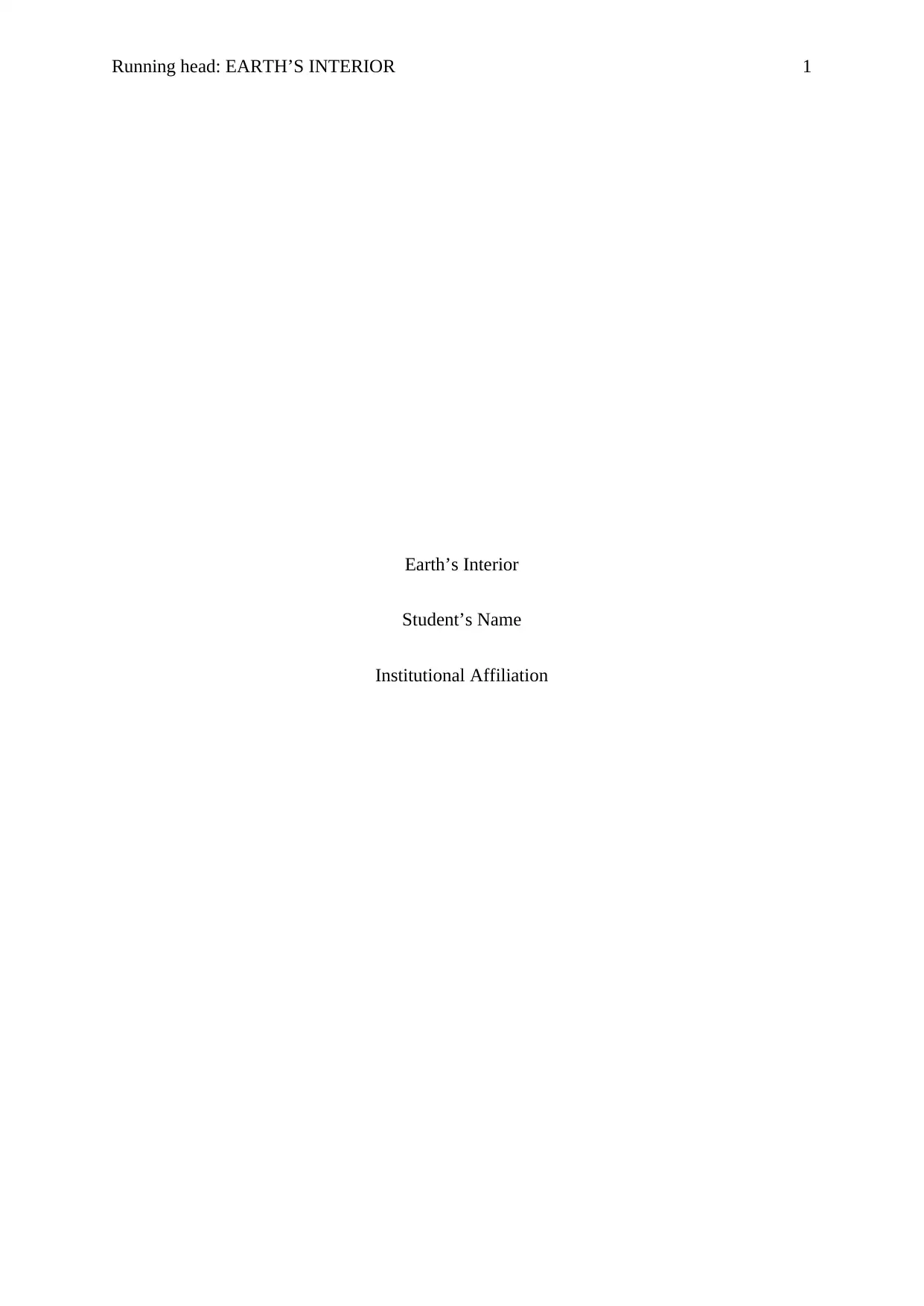
Running head: EARTH’S INTERIOR 1
Earth’s Interior
Student’s Name
Institutional Affiliation
Earth’s Interior
Student’s Name
Institutional Affiliation
Paraphrase This Document
Need a fresh take? Get an instant paraphrase of this document with our AI Paraphraser
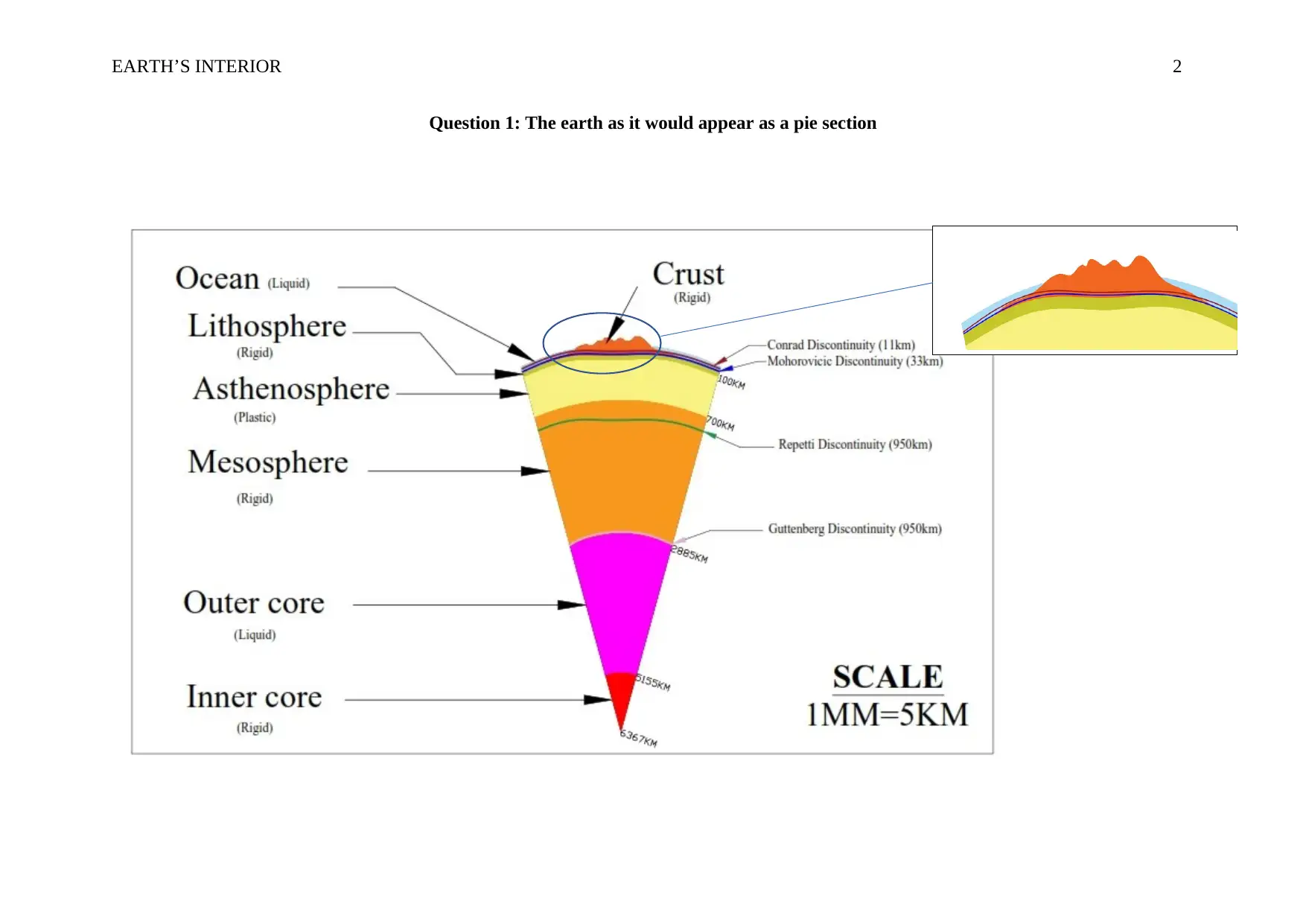
EARTH’S INTERIOR 2
Question 1: The earth as it would appear as a pie section
Question 1: The earth as it would appear as a pie section
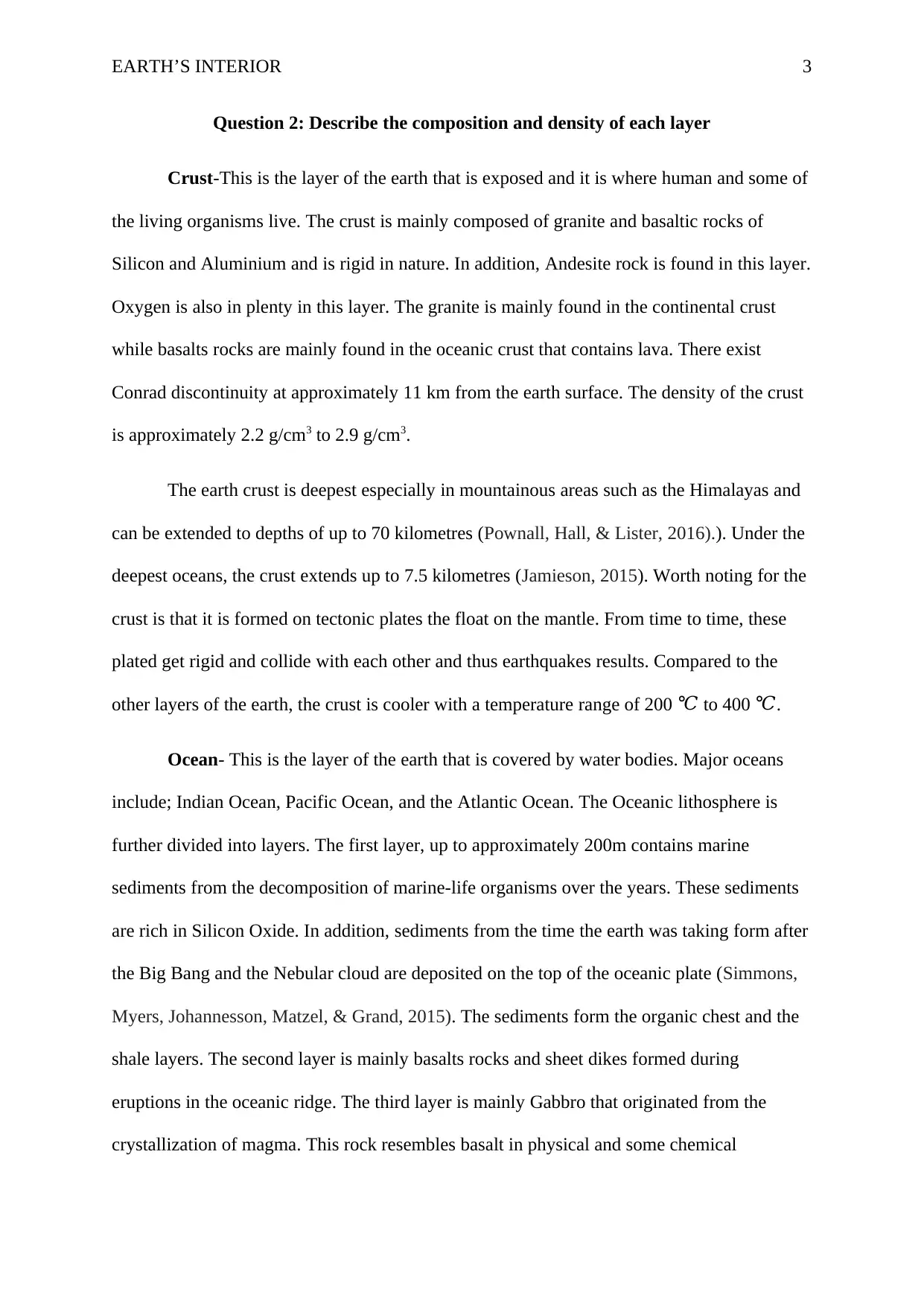
EARTH’S INTERIOR 3
Question 2: Describe the composition and density of each layer
Crust-This is the layer of the earth that is exposed and it is where human and some of
the living organisms live. The crust is mainly composed of granite and basaltic rocks of
Silicon and Aluminium and is rigid in nature. In addition, Andesite rock is found in this layer.
Oxygen is also in plenty in this layer. The granite is mainly found in the continental crust
while basalts rocks are mainly found in the oceanic crust that contains lava. There exist
Conrad discontinuity at approximately 11 km from the earth surface. The density of the crust
is approximately 2.2 g/cm3 to 2.9 g/cm3.
The earth crust is deepest especially in mountainous areas such as the Himalayas and
can be extended to depths of up to 70 kilometres (Pownall, Hall, & Lister, 2016).). Under the
deepest oceans, the crust extends up to 7.5 kilometres (Jamieson, 2015). Worth noting for the
crust is that it is formed on tectonic plates the float on the mantle. From time to time, these
plated get rigid and collide with each other and thus earthquakes results. Compared to the
other layers of the earth, the crust is cooler with a temperature range of 200 ℃ to 400 ℃.
Ocean- This is the layer of the earth that is covered by water bodies. Major oceans
include; Indian Ocean, Pacific Ocean, and the Atlantic Ocean. The Oceanic lithosphere is
further divided into layers. The first layer, up to approximately 200m contains marine
sediments from the decomposition of marine-life organisms over the years. These sediments
are rich in Silicon Oxide. In addition, sediments from the time the earth was taking form after
the Big Bang and the Nebular cloud are deposited on the top of the oceanic plate (Simmons,
Myers, Johannesson, Matzel, & Grand, 2015). The sediments form the organic chest and the
shale layers. The second layer is mainly basalts rocks and sheet dikes formed during
eruptions in the oceanic ridge. The third layer is mainly Gabbro that originated from the
crystallization of magma. This rock resembles basalt in physical and some chemical
Question 2: Describe the composition and density of each layer
Crust-This is the layer of the earth that is exposed and it is where human and some of
the living organisms live. The crust is mainly composed of granite and basaltic rocks of
Silicon and Aluminium and is rigid in nature. In addition, Andesite rock is found in this layer.
Oxygen is also in plenty in this layer. The granite is mainly found in the continental crust
while basalts rocks are mainly found in the oceanic crust that contains lava. There exist
Conrad discontinuity at approximately 11 km from the earth surface. The density of the crust
is approximately 2.2 g/cm3 to 2.9 g/cm3.
The earth crust is deepest especially in mountainous areas such as the Himalayas and
can be extended to depths of up to 70 kilometres (Pownall, Hall, & Lister, 2016).). Under the
deepest oceans, the crust extends up to 7.5 kilometres (Jamieson, 2015). Worth noting for the
crust is that it is formed on tectonic plates the float on the mantle. From time to time, these
plated get rigid and collide with each other and thus earthquakes results. Compared to the
other layers of the earth, the crust is cooler with a temperature range of 200 ℃ to 400 ℃.
Ocean- This is the layer of the earth that is covered by water bodies. Major oceans
include; Indian Ocean, Pacific Ocean, and the Atlantic Ocean. The Oceanic lithosphere is
further divided into layers. The first layer, up to approximately 200m contains marine
sediments from the decomposition of marine-life organisms over the years. These sediments
are rich in Silicon Oxide. In addition, sediments from the time the earth was taking form after
the Big Bang and the Nebular cloud are deposited on the top of the oceanic plate (Simmons,
Myers, Johannesson, Matzel, & Grand, 2015). The sediments form the organic chest and the
shale layers. The second layer is mainly basalts rocks and sheet dikes formed during
eruptions in the oceanic ridge. The third layer is mainly Gabbro that originated from the
crystallization of magma. This rock resembles basalt in physical and some chemical
⊘ This is a preview!⊘
Do you want full access?
Subscribe today to unlock all pages.

Trusted by 1+ million students worldwide
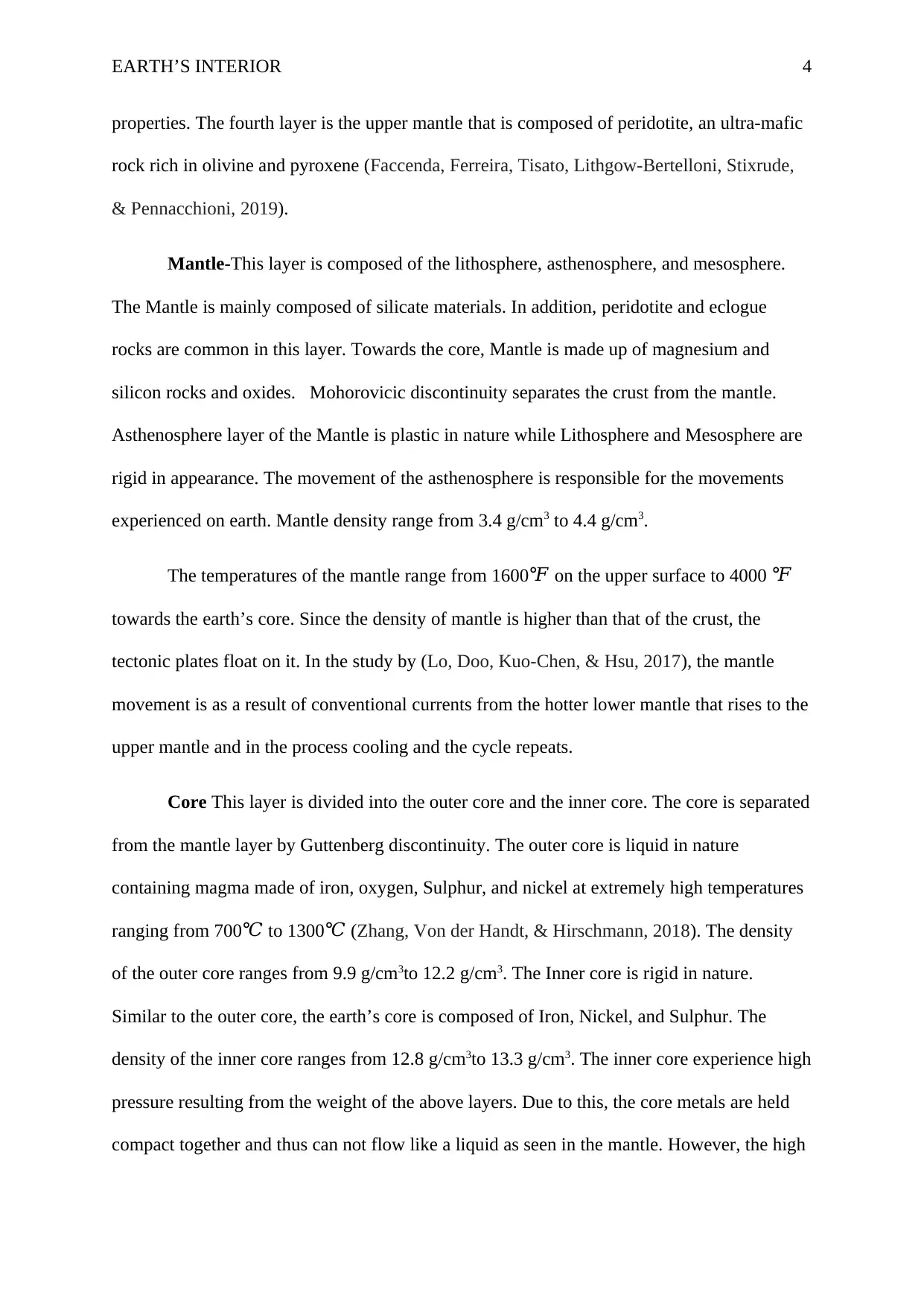
EARTH’S INTERIOR 4
properties. The fourth layer is the upper mantle that is composed of peridotite, an ultra-mafic
rock rich in olivine and pyroxene (Faccenda, Ferreira, Tisato, Lithgow‐Bertelloni, Stixrude,
& Pennacchioni, 2019).
Mantle-This layer is composed of the lithosphere, asthenosphere, and mesosphere.
The Mantle is mainly composed of silicate materials. In addition, peridotite and eclogue
rocks are common in this layer. Towards the core, Mantle is made up of magnesium and
silicon rocks and oxides. Mohorovicic discontinuity separates the crust from the mantle.
Asthenosphere layer of the Mantle is plastic in nature while Lithosphere and Mesosphere are
rigid in appearance. The movement of the asthenosphere is responsible for the movements
experienced on earth. Mantle density range from 3.4 g/cm3 to 4.4 g/cm3.
The temperatures of the mantle range from 1600℉ on the upper surface to 4000 ℉
towards the earth’s core. Since the density of mantle is higher than that of the crust, the
tectonic plates float on it. In the study by (Lo, Doo, Kuo-Chen, & Hsu, 2017), the mantle
movement is as a result of conventional currents from the hotter lower mantle that rises to the
upper mantle and in the process cooling and the cycle repeats.
Core This layer is divided into the outer core and the inner core. The core is separated
from the mantle layer by Guttenberg discontinuity. The outer core is liquid in nature
containing magma made of iron, oxygen, Sulphur, and nickel at extremely high temperatures
ranging from 700℃ to 1300℃ (Zhang, Von der Handt, & Hirschmann, 2018). The density
of the outer core ranges from 9.9 g/cm3to 12.2 g/cm3. The Inner core is rigid in nature.
Similar to the outer core, the earth’s core is composed of Iron, Nickel, and Sulphur. The
density of the inner core ranges from 12.8 g/cm3to 13.3 g/cm3. The inner core experience high
pressure resulting from the weight of the above layers. Due to this, the core metals are held
compact together and thus can not flow like a liquid as seen in the mantle. However, the high
properties. The fourth layer is the upper mantle that is composed of peridotite, an ultra-mafic
rock rich in olivine and pyroxene (Faccenda, Ferreira, Tisato, Lithgow‐Bertelloni, Stixrude,
& Pennacchioni, 2019).
Mantle-This layer is composed of the lithosphere, asthenosphere, and mesosphere.
The Mantle is mainly composed of silicate materials. In addition, peridotite and eclogue
rocks are common in this layer. Towards the core, Mantle is made up of magnesium and
silicon rocks and oxides. Mohorovicic discontinuity separates the crust from the mantle.
Asthenosphere layer of the Mantle is plastic in nature while Lithosphere and Mesosphere are
rigid in appearance. The movement of the asthenosphere is responsible for the movements
experienced on earth. Mantle density range from 3.4 g/cm3 to 4.4 g/cm3.
The temperatures of the mantle range from 1600℉ on the upper surface to 4000 ℉
towards the earth’s core. Since the density of mantle is higher than that of the crust, the
tectonic plates float on it. In the study by (Lo, Doo, Kuo-Chen, & Hsu, 2017), the mantle
movement is as a result of conventional currents from the hotter lower mantle that rises to the
upper mantle and in the process cooling and the cycle repeats.
Core This layer is divided into the outer core and the inner core. The core is separated
from the mantle layer by Guttenberg discontinuity. The outer core is liquid in nature
containing magma made of iron, oxygen, Sulphur, and nickel at extremely high temperatures
ranging from 700℃ to 1300℃ (Zhang, Von der Handt, & Hirschmann, 2018). The density
of the outer core ranges from 9.9 g/cm3to 12.2 g/cm3. The Inner core is rigid in nature.
Similar to the outer core, the earth’s core is composed of Iron, Nickel, and Sulphur. The
density of the inner core ranges from 12.8 g/cm3to 13.3 g/cm3. The inner core experience high
pressure resulting from the weight of the above layers. Due to this, the core metals are held
compact together and thus can not flow like a liquid as seen in the mantle. However, the high
Paraphrase This Document
Need a fresh take? Get an instant paraphrase of this document with our AI Paraphraser

EARTH’S INTERIOR 5
pressure ensures that the core metals are in continuous vibration and in the event of a crack
along with the upper layers, this high pressure is responsible for causing volcanos (Simmons,
Myers, Johannesson, Matzel, & Grand, 2015).
pressure ensures that the core metals are in continuous vibration and in the event of a crack
along with the upper layers, this high pressure is responsible for causing volcanos (Simmons,
Myers, Johannesson, Matzel, & Grand, 2015).
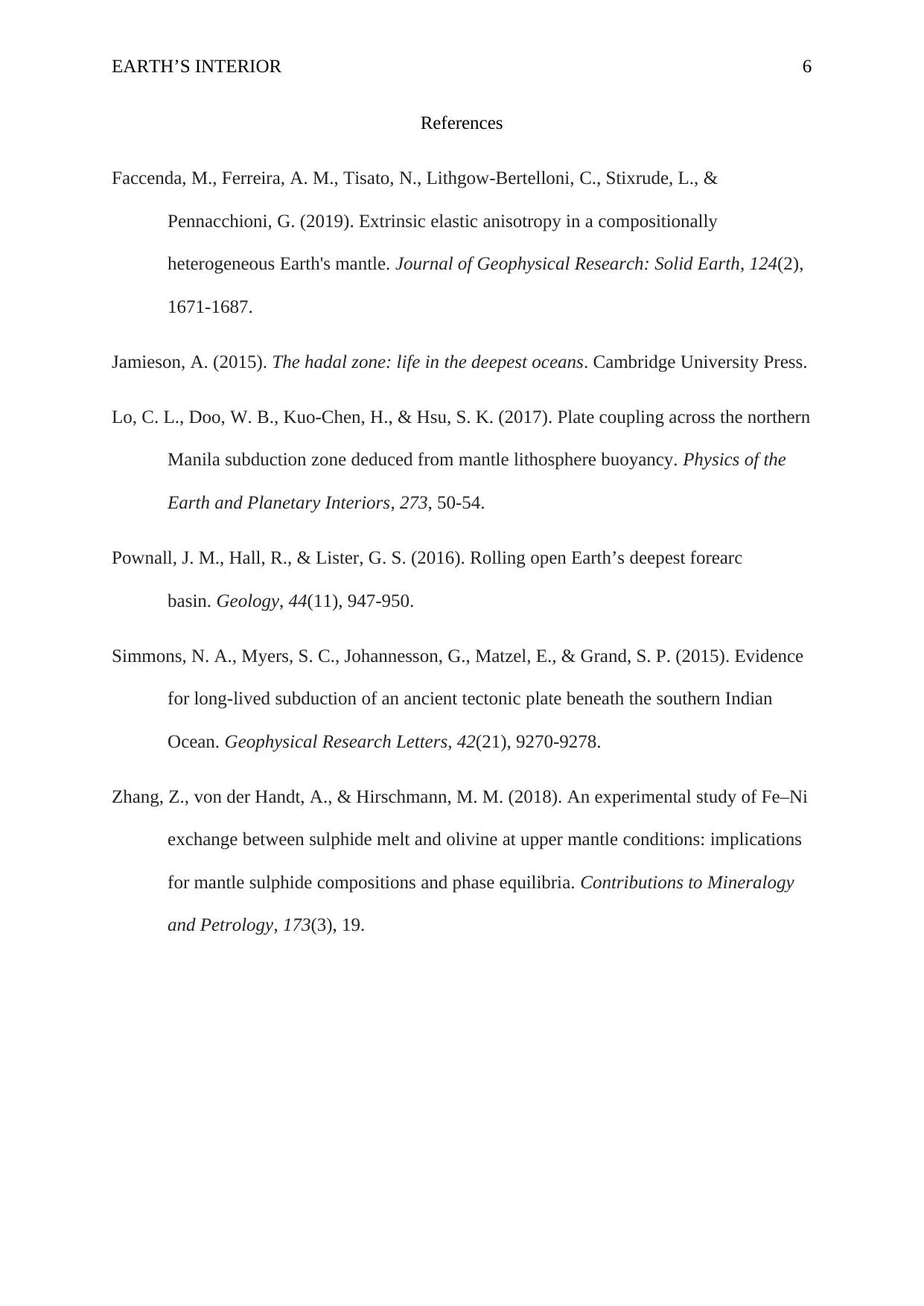
EARTH’S INTERIOR 6
References
Faccenda, M., Ferreira, A. M., Tisato, N., Lithgow‐Bertelloni, C., Stixrude, L., &
Pennacchioni, G. (2019). Extrinsic elastic anisotropy in a compositionally
heterogeneous Earth's mantle. Journal of Geophysical Research: Solid Earth, 124(2),
1671-1687.
Jamieson, A. (2015). The hadal zone: life in the deepest oceans. Cambridge University Press.
Lo, C. L., Doo, W. B., Kuo-Chen, H., & Hsu, S. K. (2017). Plate coupling across the northern
Manila subduction zone deduced from mantle lithosphere buoyancy. Physics of the
Earth and Planetary Interiors, 273, 50-54.
Pownall, J. M., Hall, R., & Lister, G. S. (2016). Rolling open Earth’s deepest forearc
basin. Geology, 44(11), 947-950.
Simmons, N. A., Myers, S. C., Johannesson, G., Matzel, E., & Grand, S. P. (2015). Evidence
for long‐lived subduction of an ancient tectonic plate beneath the southern Indian
Ocean. Geophysical Research Letters, 42(21), 9270-9278.
Zhang, Z., von der Handt, A., & Hirschmann, M. M. (2018). An experimental study of Fe–Ni
exchange between sulphide melt and olivine at upper mantle conditions: implications
for mantle sulphide compositions and phase equilibria. Contributions to Mineralogy
and Petrology, 173(3), 19.
References
Faccenda, M., Ferreira, A. M., Tisato, N., Lithgow‐Bertelloni, C., Stixrude, L., &
Pennacchioni, G. (2019). Extrinsic elastic anisotropy in a compositionally
heterogeneous Earth's mantle. Journal of Geophysical Research: Solid Earth, 124(2),
1671-1687.
Jamieson, A. (2015). The hadal zone: life in the deepest oceans. Cambridge University Press.
Lo, C. L., Doo, W. B., Kuo-Chen, H., & Hsu, S. K. (2017). Plate coupling across the northern
Manila subduction zone deduced from mantle lithosphere buoyancy. Physics of the
Earth and Planetary Interiors, 273, 50-54.
Pownall, J. M., Hall, R., & Lister, G. S. (2016). Rolling open Earth’s deepest forearc
basin. Geology, 44(11), 947-950.
Simmons, N. A., Myers, S. C., Johannesson, G., Matzel, E., & Grand, S. P. (2015). Evidence
for long‐lived subduction of an ancient tectonic plate beneath the southern Indian
Ocean. Geophysical Research Letters, 42(21), 9270-9278.
Zhang, Z., von der Handt, A., & Hirschmann, M. M. (2018). An experimental study of Fe–Ni
exchange between sulphide melt and olivine at upper mantle conditions: implications
for mantle sulphide compositions and phase equilibria. Contributions to Mineralogy
and Petrology, 173(3), 19.
⊘ This is a preview!⊘
Do you want full access?
Subscribe today to unlock all pages.

Trusted by 1+ million students worldwide
1 out of 6
Your All-in-One AI-Powered Toolkit for Academic Success.
+13062052269
info@desklib.com
Available 24*7 on WhatsApp / Email
![[object Object]](/_next/static/media/star-bottom.7253800d.svg)
Unlock your academic potential
Copyright © 2020–2025 A2Z Services. All Rights Reserved. Developed and managed by ZUCOL.